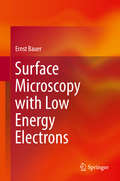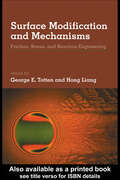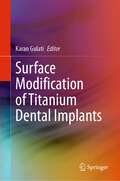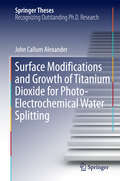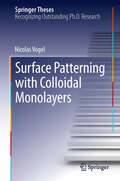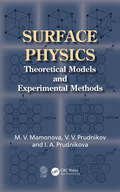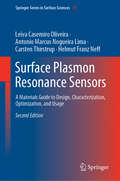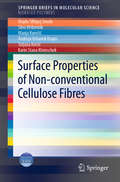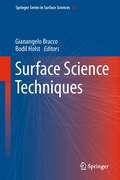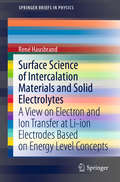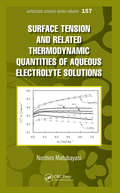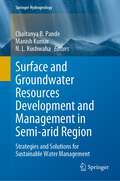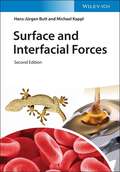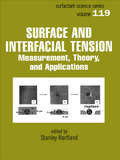- Table View
- List View
Surface Microscopy with Low Energy Electrons
by Ernst BauerThis book, written by a pioneer in surface physics and thin film research and the inventor of Low Energy Electron Microscopy (LEEM), Spin-Polarized Low Energy Electron Microscopy (SPLEEM) and Spectroscopic Photo Emission and Low Energy Electron Microscopy (SPELEEM), covers these and other techniques for the imaging of surfaces with low energy (slow) electrons. These techniques also include Photoemission Electron Microscopy (PEEM), X-ray Photoemission Electron Microscopy (XPEEM), and their combination with microdiffraction and microspectroscopy, all of which use cathode lenses and slow electrons. Of particular interest are the fundamentals and applications of LEEM, PEEM, and XPEEM because of their widespread use. Numerous illustrations illuminate the fundamental aspects of the electron optics, the experimental setup, and particularly the application results with these instruments. Surface Microscopy with Low Energy Electrons will give the reader a unified picture of the imaging, diffraction, and spectroscopy methods that are possible using low energy electron microscopes.
Surface Modification and Mechanisms: Friction, Stress, and Reaction Engineering
by Hong Liang George E. TottenNavigating through an extensive compilation of surface modification reactions and processes for specific tribological results, this reference compiles detailed studies, many not found in other texts, on various residual stresses, reaction processes and mechanisms, heat treatment methods, plasma-based techniques, laser impingement, nanometer scale surface modification, and more. Surface Modification and Mechanisms: Friction, Stress, and Reaction Engineering offers guidelines for the consideration and design of wear and frictional performance and provides a unique understanding of surface structural changes that occur during various engineering procedures.
Surface Modification of Titanium Dental Implants
by Karan GulatiThis book provides a comprehensive technical and scientific overview of the surface modification of titanium dental implants. Coverage ranges from basic concepts of surface modification to advanced micro- and nano-engineering strategies employed to achieve augmented bioactivity to meet the needs of compromised patient conditions.A special focus of the book is advanced state-of-the-art electrochemically anodized nanostructures fabricated on implants towards enhanced bioactivity and local therapy.Surface Modification of Titanium Dental Implants will keep you current in the domain of titanium dental implants and will provide an improved understanding of their performance and application. The book will benefit engineers, clinicians, and researchers in biomaterials, biomedical engineering, dental and bone implants, nano-engineering, and technology.
Surface Modifications and Growth of Titanium Dioxide for Photo-Electrochemical Water Splitting
by John Callum AlexanderThis outstanding thesis provides a wide-ranging overview of the growth of titanium dioxide thin films and its use in photo-electrochemicals such as water splitting. The context for water splitting is introduced with the theory of semiconductor-liquid junctions, which are dealt with in detail. In particular plasmonic enhancement of TiO2 by the addition of gold nanoparticles is considered in depth, including a thorough and critical review of the literature, which discusses the possible mechanisms that may be at work. Plasmonic enhancement is demonstrated with gold nanoparticles on Nb-doped TiO2. Finally, the use of temperature and pressure to control the phase and morphology of thin films grown by pulsed laser deposition is presented.
Surface Modified Carbons as Scavengers for Fluoride from Water
by Venkataraman SivasankarThis book discusses the problems and feasible remediation of fluoride contamination in groundwater. The book investigates applications of various carbons derived from bio-mass and bio-polymers. It also inquires into surface modified carbons that use inorganic ions to help remove excess fluoride ions in drinking water and wastewater effluents. The compliance of kinetic and isotherm models with fluoride sorption is covered, and the suggested mechanisms of defluoridation by surface modified carbon materials is described.
Surface Patterning with Colloidal Monolayers
by Nicolas VogelHow can the two dimensional crystallization of colloids be used to form highly ordered colloidal monolayers on solid substrates? What application does this have in generating arrays of nanostructures? These questions are addressed in Nicolas Vogel's thesis. Vogel describes a simple preparation method for the formation of uniform colloidal crystals over large areas, which he refines to yield more complex binary and non-close-packed arrangements. These monolayers can be applied to a process termed colloidal lithography which is used to prepare high quality metallic nanostructures with tailored properties defined to suit a variety of applications. Moreover, the author describes a method used to create metallic nanodot arrays with a resolution unprecedented for colloidal lithography methods. The author also outlines methodology to embed nanoparticle arrays into the substrate, which is developed and used to design robust, re-usable biosensor platforms and nanoscale patterns of biomimetic lipid bilayer membranes. The research in this thesis has led to a large number of publications in internationally renowned journals.
Surface Phenomena in the Structural and Mechanical Behaviour of Solid Polymers
by L. Volynskii N. F. BakeevSurface Phenomena in the Structural and Mechanical Behaviour of Solid Polymers explores the role of various surface phenomena in the structural and mechanical behaviour of amorphous and semicrystalline polymers. This book: Discusses the development of the interfacial surface in the deformation of polymers Examines the healing of interfacial surfaces in polymers Inspects the structure and properties of polymers in thin films and surface layers Evaluates the mechanism of inelastic deformation in glassy amorphous polymers Investigates strain softening and the phenomena taking place upon deformation of polymers in active liquid media Covers the Rehbinder effect, or the adsorption reduction of the strength of solids Describes the properties of polymers in environmental or solvent crazing Analyses the interaction of the highly developed surface of crazed polymers with diverse low- and high-molecular mass components Addresses the instability and self-organisation of surface layers in polymers and diverse polymer systems Presents theoretical speculations concerning the structurally mechanical behaviour of ‘a rigid coating on a soft substratum’ (RCSS) systems Assesses the stress–strain properties of the thin surface layers of polymers and the nanometric coatings deposited on their surfaces Highlights the efficacy of the approaches developed for RCSS systems for the analysis and description of natural phenomena Details the applied aspects of surface phenomena in the structurally mechanical behaviour of polymers Thus, Surface Phenomena in the Structural and Mechanical Behaviour of Solid Polymers provides a useful framework for the development of new and innovative polymer-based materials.
Surface Physics: Theoretical Models and Experimental Methods
by Marina V. Mamonova Vladimir V. Prudnikov Irina A. PrudnikovaThe demands of production, such as thin films in microelectronics, rely on consideration of factors influencing the interaction of dissimilar materials that make contact with their surfaces. Bond formation between surface layers of dissimilar condensed solids-termed adhesion-depends on the nature of the contacting bodies. Thus, it is necessary to d
Surface Plasmon Enhanced, Coupled and Controlled Fluorescence
by Chris D. GeddesExplains the principles and current thinking behind plasmon enhanced Fluorescence Describes the current developments in Surface Plasmon Enhanced, Coupled and Controlled Fluorescence Details methods used to understand solar energy conversion, detect and quantify DNA more quickly and accurately, and enhance the timeliness and accuracy of digital immunoassays Contains contributions by the world’s leading scientists in the area of fluorescence and plasmonics Describes detailed experimental procedures for developing both surfaces and nanoparticles for applications in metal-enhanced fluorescence
Surface Plasmon Resonance
by Marcel J. Fischer Nico J. MolWhile commercial instruments have expanded the usage and the related literature has increased, the quality of surface plasmon resonance (SPR) research has been hindered by a lack of knowledge of the processes that influence the SPR signal. In Surface Plasmon Resonance: Methods and Protocols, experts in the field present a wide variety of applications involving commercially available SPR instruments. The heart of the SPR technique is to construct a dedicated surface for an assay. Protocols describe such surfaces for many needs, including the study of membrane bound proteins. Beyond the protocols-based chapters, the volume also highlights the backgrounds of vital issues in the use of SPR, including processes occurring within the hydrogel environment of sensors and on lipid membrane surfaces as well as the analysis of kinetic information. Written in the highly successful Methods in Molecular BiologyTM series format, chapters include introductions to their respective topics, lists of the necessary materials and reagents, step-by-step, readily reproducible protocols, and notes on troubleshooting and avoiding known pitfalls. Authoritative and cutting-edge, Surface Plasmon Resonance: Methods and Protocols fills a need for well-described, hands-on SPR experimental protocols and promises to inspire the adaptation of these techniques to fit the needs of labs around the world.
Surface Plasmon Resonance Imaging: Basic Theory and Practical Methodology (Lecture Notes in Chemistry #95)
by Yi ChenThis book introduces the fundamentals, instruments, methodology, and applications of surface plasmon resonance imaging (SPRi) and related techniques. It provides an overview of SPRi development and an easy-to-understand interpretation of theory and operation principles. Some unique ideas proposed by the authors to design and set up SPRi devices and methods are disclosed for the first time. Crucial manipulation experiences are also summarized here, including chip surface functionalization, sensitivity enhancement and coupling of SPRi with other analytical techniques. The application of SPRi for molecular interaction study, featuring high throughput, label-freeness, and physiologically compatible analysis, is discussed in detail. This book is of interest and useful to a wide readership in bioanalytical chemistry, molecular biology, and many related interdisciplinary fields.
Surface Plasmon Resonance Sensors: A Materials Guide to Design, Characterization, Optimization, and Usage (Springer Series in Surface Sciences #70)
by Leiva Casemiro Oliveira Carsten Thirstrup Helmut Franz Neff Antonio Marcus LimaThis significantly extended second edition addresses the important physical phenomenon of Surface Plasmon Resonance (SPR) or Surface Plasmon Polaritons (SPP) in thin metal films, a phenomenon which is exploited in the design of a large variety of physico-chemical optical sensors. In this treatment, crucial materials aspects for design and optimization of SPR sensors are investigated and described in detail. The text covers a selection of nanometer thin metal films, ranging from free-electron to the platinum-type conductors, along with their combination with a large variety of dielectric substrate materials, and associated individual layer and opto-geometric arrangements. Whereas the first edition treated solely the metal-liquid interface, the SP-resonance conditions considered here are expanded to cover the metal-gas interface in the angular and wavelength interrogation modes, localized and long-range SP's and the influence of native oxidic ad-layers in the case of non-noble metals. Furthermore, a selection of metal grating structures that allow SP excitation is presented, as are features of radiative SP's. Finally, this treatise includes as-yet hardly explored SPR features of selected metal–metal and metal–dielectric superlattices. An in-depth multilayer Fresnel evaluation provides the mathematical tool for this optical analysis, which otherwise relies solely on experimentally determined electro-optical materials parameters.
Surface Processing of Light Alloys Subject to Concentrated Energy Flows
by Victor Gromov Sergey Konovalov Yurii Ivanov Xizhang ChenThis book presents studies on the surface modification of aluminum and titanium alloys by electric explosive alloying and electron-beam processing. It also describes and analyzes the physical mechanism of energy actions of these technologies on physical and mechanical properties and discusses their potential use in industry to improve the characteristics of finished products. The book is intended for specialists in the field of condensed matter physics, metallurgy and heat treatment and materials science, as well as graduate and senior students in relevant fields.
Surface Properties of Non-conventional Cellulose Fibres (SpringerBriefs in Molecular Science)
by Manja Kurečič Karin Stana Kleinschek Majda Sfiligoj Smole Silvo Hribernik Andreja Urbanek Krajnc Tatjana KrežeThe authors describe how sustainable textile fibers from crops such as quinoa, grass, hops, corn and wheat stems, etc. have recently begun to generate great interest. The structure-property relationships of such non-conventional cellulose fibers are studied in this brief, as are their sorption and surface properties which are of primary importance. A systematic review of each fiber's properties is given, the emphasis is placed on the water sorption capacity, the fiber's surface potential, and fibrillation properties.
Surface Science Techniques
by Bodil Holst Gianangelo BraccoThe book describes the experimental techniques employed to study surfaces and interfaces. The emphasis is on the experimental method. Therefore all chapters start with an introduction of the scientific problem, the theory necessary to understand how the technique works and how to understand the results. Descriptions of real experimental setups, experimental results at different systems are given to show both the strength and the limits of the technique. In a final part the new developments and possible extensions of the techniques are presented. The included techniques provide microscopic as well as macroscopic information. They cover most of the techniques used in surface science.
Surface Science of Intercalation Materials and Solid Electrolytes: A View on Electron and Ion Transfer at Li-ion Electrodes Based on Energy Level Concepts (SpringerBriefs in Physics)
by René HausbrandThis book shares essential insights into the formation and properties of ionic interfaces based on the energy level structures of their interfaces obtained using a surface science approach. It covers both interfaces with liquid and solid electrolyte contacts, and includes different material classes, such as oxides and phosphates. The specific material properties result in particular effects observed at interfaces, which are often not yet, or not sufficiently, taken into account in battery development and technologies.Discussing fundamental issues concerning the properties of intercalation electrodes and electrode–solid electrolyte interfaces, the book investigates the factors that determine voltage, kinetics and reactivity. It presents experimental results on interface formation, and relates them to electron and ion energy levels in the materials and at their interfaces. It explores these topics integrating electrochemistry, solid-state ionics and semiconductor physics, and accordingly will appeal not only to battery scientists, but also to a broader scientific community, including material scientists and electrochemists.
Surface Structure Modification and Hardening of Al-Si Alloys
by Denis A. Romanov Stanislav. V. Moskovskii Viktor E. GromovSurface Structure Modification and Hardening of Al-SI Alloys explores the hardening of material surfaces using concentrated energy flows resulting in the nanostructuring of surface layers. The authors demonstrate how these methods achieve a reduction in plastic deformation of the surface and a more uniform distribution of elastic stresses near the surface during operational use, significantly reducing part failure. It presents results from research and scientific and technological enterprises involved with the modification of light alloy surfaces for use in the automobile and aerospace industries. Additional key features include: Addresses theoretical and experimental research computer simulations of structural phase transformations at the nanolevel to create new materials Details and compares electroexplosion alloying, electron beam processing and electron-plasma alloying of an Al-Si Alloy Explains multiphase plasma jet treatment to obtain high-quality coatings with good and high functional properties This reference is a valuable resource for specialists in the field of physical material science, condensed state physics, metal science and thermal treatment and will be of interest to undergraduate and post-graduate students in these fields.
Surface Tension and Related Thermodynamic Quantities of Aqueous Electrolyte Solutions
by Norihiro MatubayasiSurface tension provides a thermodynamic avenue for analyzing systems in equilibrium and formulating phenomenological explanations for the behavior of constituent molecules in the surface region. While there are extensive experimental observations and established ideas regarding desorption of ions from the surfaces of aqueous salt solutions, a more
Surface Tension in Microsystems: Engineering Below the Capillary Length
by Pierre LambertThis book describes how surface tension effects can be used by engineers to provide mechanical functions in miniaturized products (<1 mm). Even if precursors of this field such as Jurin or Laplace already date back to the 18th century, describing surface tension effects from a mechanical perspective is very recent. The originality of this book is to consider the effects of capillary bridges on solids, including forces and torques exerted both statically and dynamically by the liquid along the 6 degrees-of-freedom. It provides a comprehensive approach to various applications, such as capillary adhesion (axial force), centering force in packaging and micro-assembly (lateral force) and recent developments such as a capillary motor (torque). It devises how surface tension can be used to provide mechanical functions such as actuation (bubble-actuated compliant table), sealing and tightness, energy harvesting, nanodispending.
Surface Water and Groundwater Quality for Sustainable Utilization: Advanced Methods and Technology (Springer Hydrogeology)
by Chaitanya Baliram Pande Dimple Jitendra RajputThis book provides a comprehensive overview of surface water and groundwater quality, including its analytical methods, and remote sensing and soft computing techniques. Furthermore, the book addresses the pressing challenges surrounding sustainable use of surface water and groundwater around the globe. The importance of their quality management cannot be overstated in the face of ecological balance and climate change issues. The water quality of surface water and groundwater is affected by numerous factors, and their significance to every sector of society cannot be overlooked. This is particularly true in emerging countries such as India where population growth has led to an unparalleled demand for water and millions of people rely on contaminated water for drinking and irrigation purposes. The book chapters cover a broad range of topics such as importance of water quality assessment for drinking and irrigation, methods and techniques, contamination sources and remedial techniques, impacts of water quality on crop, soil and productivity, climate change impacts on water quality, sustainable development policy and soft computing techniques for water quality assessment. The multidisciplinary approach and cutting-edge techniques make the book an essential resource for anyone involved in sustainable development, planning and management.
Surface and Colloid Chemistry in Advanced Ceramics Processing (Surfactant Science Ser. #51)
by Robert J. Pugh Lennart BergströmEmphasizes the importance of surface and colloid chemistry in the manufacture of high-performance ceramics. Examines processing-property relationships, powderproductionandcharacte6zation,the dispersion properties of powders in liquids, the rheology of concentrated suspensions, and the surface and colloid chemistry aspects of the most widely used forming methods.
Surface and Groundwater Resources Development and Management in Semi-arid Region: Strategies and Solutions for Sustainable Water Management (Springer Hydrogeology)
by Manish Kumar Chaitanya B. Pande N. L. KushwahaThis book explains the challenges for efficient sustainable surface and groundwater development and management with the focus on India and other countries, providing a stable output presentation by using machine learning data mining methods, and modeling. It is a combination of machine learning, modeling, google earth engine, climate data modeling, remote sensing and GIS techniques, surface water modeling, AHP modeling, groundwater quality analysis, aquifer mapping, land use and land cover analysis, forecasting of water and rainfall and so on, its use to sustainable development, planning, and management of groundwater purposes in India and other countries. The main purpose of this book will develop better outlines for the development of surface and groundwater and management in the semi-arid region climate, which supports the Sustainable Development Goals (SDGs) in India, especially on sustainable surface water and groundwater resources management. This book provides a multidisciplinary overview for the faculty members, administrators scientists, policymakers, social science, and professionals involved in the various aspects of sustainable groundwater development, planning, and management.
Surface and Interfacial Aspects of Cell Adhesion
by K. L. Mittal A. CarréCell adhesion comes into play in almost all domains of life. The range of situations in which it occurs, involving organisms, living tissues, microorganisms or single cells, is endless. Cell adhesion is involved in the binding of a cell to a surface, extracellular matrix, or another cell using cell adhesion molecules. It is crucial in the formation
Surface and Interfacial Forces
by Hans-Jürgen Butt Michael KapplA general introduction to surface and interfacial forces, perfectly combining theoretical concepts, experimental techniques and practical applications. In this completely updated edition all the chapters have been thoroughly revised and extended to cover new developments and approaches with around 15% new content. A large part of the book is devoted to surface forces between solid surfaces in liquid media, and while a basic knowledge of colloid and interface science is helpful, it is not essential since all important concepts are explained and the theoretical concepts can be understood with an intermediate knowledge of mathematics. A number of exercises with solutions and the end-of-chapter summaries of the most important equations, facts and phenomena serve as additional tools to strengthen the acquired knowledge and allow for self-study. The result is a readily accessible text that helps to foster an understanding of the intricacies of this highly relevant topic.
Surface and Interfacial Tension: Measurement, Theory, and Applications (Surfactant Science Ser. #Vol. 119)
by Stanley HartlandThis edited volume offers complete coverage of the latest theoretical, experimental, and computer-based data as summarized by leading international researchers. It promotes full understanding of the physical phenomena and mechanisms at work in surface and interfacial tensions and gradients, their direct impact on interface shape and movement, and t
